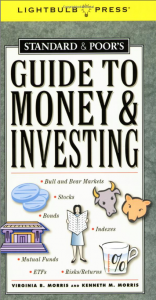
If you want to understand the financial markets and financial instruments in particular, you will probably have many questions. Where do you even start? I’d recommend you start here.
You may ask:
What are stocks good for? And what do bonds do? Why do we need indexes, mutual funds, options, futures and all the rest of these abstract financial instruments? One of if not the most important branches of our economy is the financial system. Since it’s early beginnings in medieval Italy, it has gotten more and more complex and now constantly makes headlines.
This out-of-print book from 2005 tries to give a solid interview over all aspects of the financial system, in particular in the USA. Used copies are still available on Amazon for little money. In roughly more than 190 pages, it will give you an overview of all important terms used in the finance industry. The books division into 8 chapters makes it easy to read up on:
- money and markets
- stocks
- bonds
- indexes
- mutual funds
- options
- futures
- alternative investments (hedge funds, real estate, …)
Each chapter is covered on roughly 20 pages each. Within those 20 pages, the authors cover all important aspects of each topic. For example, the chapter on bonds, will tell you what bonds are, what different kinds of bonds there are, how they are bought and sold and what the government has to do with them. On almost every page there are some figures or info graphics to explain certain concepts. On some pages, this strategy seems to be going a bit too far and feel overwhelming to the reader so that one doesn’t know where to begin, but in general it is a decent approach to keep the material from becoming too dry and formal. It keeps the reader engaged.
Since each topic is split into smaller chunks, you can decide to read as much or as little as you want. Most of the time, you will get a solid basic understanding of the most important concepts. There are a few places though, that would require some additional resources. To me the weakest section is the one about the Federal Reserve system, which I think gives one the wrong impression about its relationship to the business cycle (boom and busts in the economy). On this topic, I’d refer people over to this wiki entry on mises.org. Since this book was printed in 2005, you will not find anything that has changed since the great financial crisis of 2008. On Freddy Mac and Faenny Mae, you will be served better, if you consult wikipedia, after reading the section in the book.
A keyword index allows one to jump to the sections that you are most interested in. That allows the book to serve as a regular reference as well. The book’s advantage over many finance websites is, that you’ve got immediate access to the broader context of a topic and your attention will be quickly drawn to related topics you wouldn’t have considered.
I think the main strength of this book is to give you an overview of what financial instruments and regulations there are and what they are used for. If you want to learn about cause and effect, financial crises, so-called macroeconomics, then a different book would serve those purposes better. If you are interested in the former, get the book here. There is also a more expensive kindle version available here. Since I haven’t bought it, I cannot vouch for the quality of the conversion to the digital format.